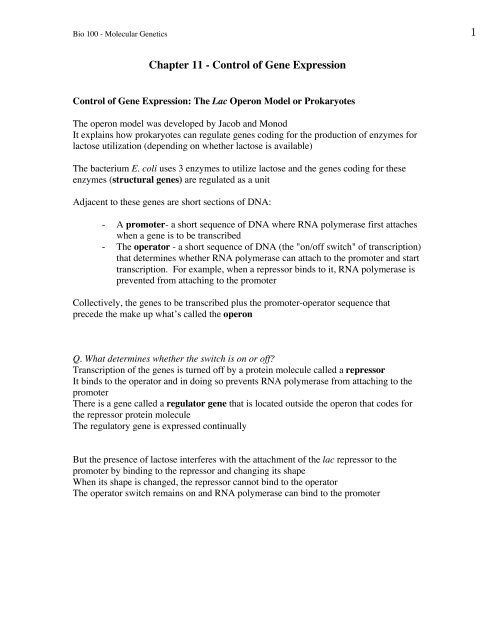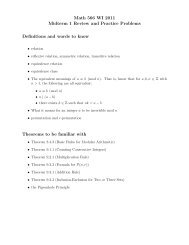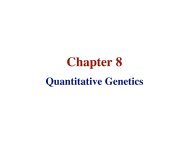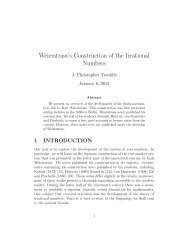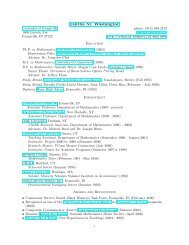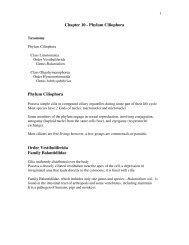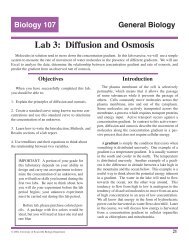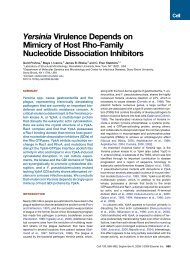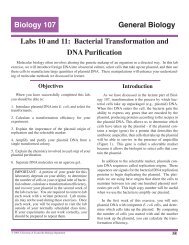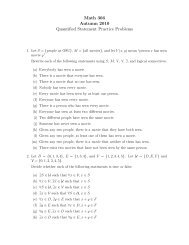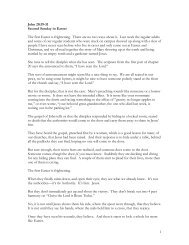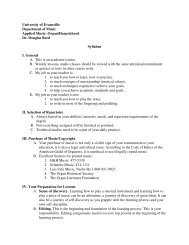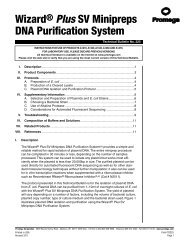Chapter 11 - Control of Gene Expression
Chapter 11 - Control of Gene Expression
Chapter 11 - Control of Gene Expression
- No tags were found...
You also want an ePaper? Increase the reach of your titles
YUMPU automatically turns print PDFs into web optimized ePapers that Google loves.
Bio 100 - Molecular <strong>Gene</strong>tics 1<strong>Chapter</strong> <strong>11</strong> - <strong>Control</strong> <strong>of</strong> <strong>Gene</strong> <strong>Expression</strong><strong>Control</strong> <strong>of</strong> <strong>Gene</strong> <strong>Expression</strong>: The Lac Operon Model or ProkaryotesThe operon model was developed by Jacob and MonodIt explains how prokaryotes can regulate genes coding for the production <strong>of</strong> enzymes forlactose utilization (depending on whether lactose is available)The bacterium E. coli uses 3 enzymes to utilize lactose and the genes coding for theseenzymes (structural genes) are regulated as a unitAdjacent to these genes are short sections <strong>of</strong> DNA:- A promoter- a short sequence <strong>of</strong> DNA where RNA polymerase first attacheswhen a gene is to be transcribed- The operator - a short sequence <strong>of</strong> DNA (the "on/<strong>of</strong>f switch" <strong>of</strong> transcription)that determines whether RNA polymerase can attach to the promoter and starttranscription. For example, when a repressor binds to it, RNA polymerase isprevented from attaching to the promoterCollectively, the genes to be transcribed plus the promoter-operator sequence thatprecede the make up what’s called the operonQ. What determines whether the switch is on or <strong>of</strong>f?Transcription <strong>of</strong> the genes is turned <strong>of</strong>f by a protein molecule called a repressorIt binds to the operator and in doing so prevents RNA polymerase from attaching to thepromoterThere is a gene called a regulator gene that is located outside the operon that codes forthe repressor protein moleculeThe regulatory gene is expressed continuallyBut the presence <strong>of</strong> lactose interferes with the attachment <strong>of</strong> the lac repressor to thepromoter by binding to the repressor and changing its shapeWhen its shape is changed, the repressor cannot bind to the operatorThe operator switch remains on and RNA polymerase can bind to the promoter
Bio 100 - Molecular <strong>Gene</strong>tics 2Cell Differentiation and Cloning <strong>of</strong> EukaryotesDuring growth and development among eukaryotes, individual cells undergodifferentiation – they become specialized in structure and functionAnd differentiation results from selective gene expressionQ. Among the differentiated cells <strong>of</strong> eukaryotes, are all genes still present?And, if they are, do the differentiated cells retain the ability to express them?A nuclear transplantation experiment addressed these questions among animalsIn nuclear transplantation, the nucleus <strong>of</strong> an eggs or zygote is replaced with the nucleusfrom a differentiated cellQ. Will the transplanted nucleus support the development <strong>of</strong> the embryo?In the 1950s, nuclear transplantation experiments were performed by Briggs and Kingusing frogsThey destroyed the nuclei <strong>of</strong> frog egg cells using UV light and then transplanted nucleiremoved from intestinal cells into the eggsMany <strong>of</strong> these transplanted eggs cells began to develop, and a few developed into normaltadpoles (clones)In 1997, Wilmut and his colleagues were successful in cloning a mammal, using thenucleus <strong>of</strong> a mammal cellThe cloning <strong>of</strong> dolly and tadpoles is called reproductive cloningAnother type <strong>of</strong> cloning is called therapeutic cloning – creation <strong>of</strong> an early embryo (i.e.,a blastocyst stage <strong>of</strong> about 200 cells; a stage before implantation into the mother’s uterus)These blastocysts are important because they contain embryonic stem cells – cells whicheventually give rise to all the differentiated kinds <strong>of</strong> cells <strong>of</strong> the bodyThe harvested embryonic stems cells can be used to create specialized types <strong>of</strong> cells thatare damaged


